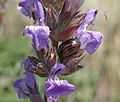Chrysolina americana
| Chrysolina americana | |
|---|---|
| | |
| Chrysolina americana on Lavender (Lavandula sp.) | |
| Scientific classification | |
| Kingdom: | Animalia |
| Phylum: | Arthropoda |
| Class: | Insecta |
| Order: | Coleoptera |
| Family: | Chrysomelidae |
| Genus: | Chrysolina |
| Species: | Chrysolina americana |
| Binomial name | |
| Chrysolina americana (Linnaeus, 1758) | |
Chrysolina americana, common name Rosemary Beetle, is a species of beetles belonging to the family Chrysomelidae.
Description
Chrysolina americana can reach a length of 5–8 millimetres (0.20–0.31 in). They have colourful elytra with metallic green and purple longitudinal stripes. The wings are quite short, so these beetles can not fly.
This species feeds on various aromatic Lamiaceae, mainly on rosemary (Rosmarinus officinalis) (hence the common name), lavender (Lavandula) and thyme (Thymus).
In the Mediterranean region females lay their eggs in late summer on the leaves of the host plants. The larvae show whitish to blackish bands. Larval development continues during the winter months. The pupal stage lasts about three weeks. The imago is released in the spring.
Distribution
Despite the species name americana, this leaf beetle is native and common to eastern Europe and the Mediterranean sub-region.
Introduction to the United Kingdom
This species was first discovered living outdoors in the United Kingdom in 1994. By 2002 it had become widespread in the London area, and spreading rapidly throughout. Although it is susceptible to some pesticides, it is usually recommended that home growers pick off beetles by hand, or shake them off onto a sheet of paper to remove them, if the plant affected by them is intended for culinary purposes.
Gallery
-

Rosemary Beetle, on Rosmarinus officinaliss in Molyvos, Greece.
-

Imago
-

Mating
-

Chrysolina americana on Salvia
-

Larva on Rosmarinus officinalis